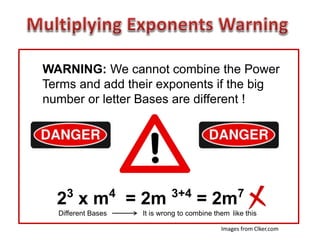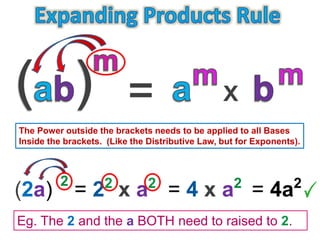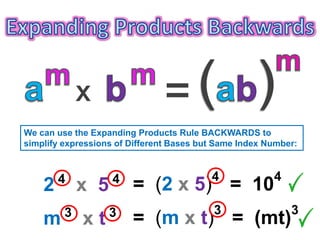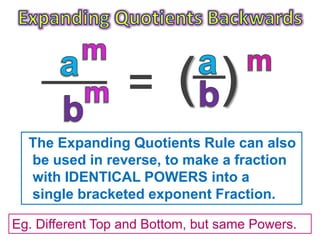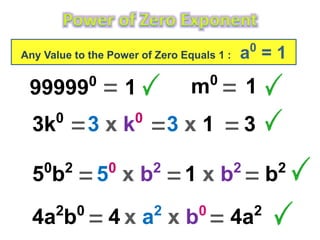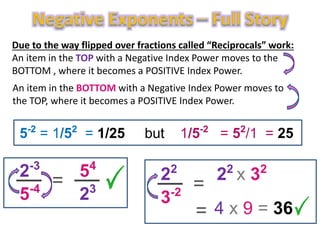Exponents Rules
- 2. Let’s consider am x an If we have any base that is the same “a”, then we can skip expanding out the powers of the exponents “m’ and “n”, and use the fast track rule which is to Add the Exponents am x an = am + n This rule works for both letters and numbers
- 3. WARNING: We cannot combine the Power Terms and add their exponents if the big number or letter Bases are different ! 23 x m4 = 2m 3+4 = 2m7 Different Bases It is wrong to combine them like this Images from Clker.com
- 4. Let’s consider am ÷ an or am an If we have any base that is the same “a”, then we can skip expanding and cancelling the exponents “m’ and “n”, and use the fast track rule and SUBTRACT the Exponents am ÷ an = am - n This rule works for both letters and numbers
- 5. The Power of Power Rule involves Multiplying the two Index Powers. (23 ) 4 = 23 x 4 = 212 (n2 ) 4 = n2 x 4 = n8 This rule only works if there is a single Positive Base inside the brackets.
- 6. WARNING: The Power of Power Rule only works if there is one single positive Base (eg. a number or letter) inside the brackets! (2n3 )4 = 2n3x4 = 2n12 Two Bases It is wrong to expand them like this Images from Clker.com
- 7. Eg. The 2 and the a BOTH need to raised to 2. The Power outside the brackets needs to be applied to all Bases Inside the brackets. (Like the Distributive Law, but for Exponents). (2a) 2 = 22 x a2 = 4 x a2 = 4a2
- 8. We can use the Expanding Products Rule BACKWARDS to simplify expressions of Different Bases but Same Index Number: 2 4 x 5 4 = (2 x 5)4 = 104 m 3 x t 3 = (m x t)3 = (mt)3
- 9. Eg. The a and the b BOTH need to be Powered. The Expanding Quotients Rule involves applying the Power Outside of the brackets, onto every item that is inside the brackets.
- 10. Eg. Different Top and Bottom, but same Powers. The Expanding Quotients Rule can also be used in reverse, to make a fraction with IDENTICAL POWERS into a single bracketed exponent Fraction.
- 11. 999990 1= Any Value to the Power of Zero Equals 1 : a0 = 1 m0 1= 3k0 3 x k0 3 x 1 3= = = 50 b2 50 x b2 1 x b2 b2 = = = 4a2 b0 4 x a2 x b0 4a2 = =
- 12. Note “a” cannot be zero, because 1/0 is not possible . A Negative exponent means we have to re-write our Power term as a 1/ Fraction. Negative Exponents are Positive Fractions.
- 13. Due to the way flipped over fractions called “Reciprocals” work: An item in the TOP with a Negative Index Power moves to the BOTTOM , where it becomes a POSITIVE Index Power. An item in the BOTTOM with a Negative Index Power moves to the TOP, where it becomes a POSITIVE Index Power. 5-2 = 1/52 = 1/25 but 1/5-2 = 52 /1 = 25 2-3 54 5-4 23= 22 22 x 32 3-2 = 4 x 9 = 36=
- 14. http://passyworldofmathematics.com Visit our Site for Free Mathematics PowerPoints


